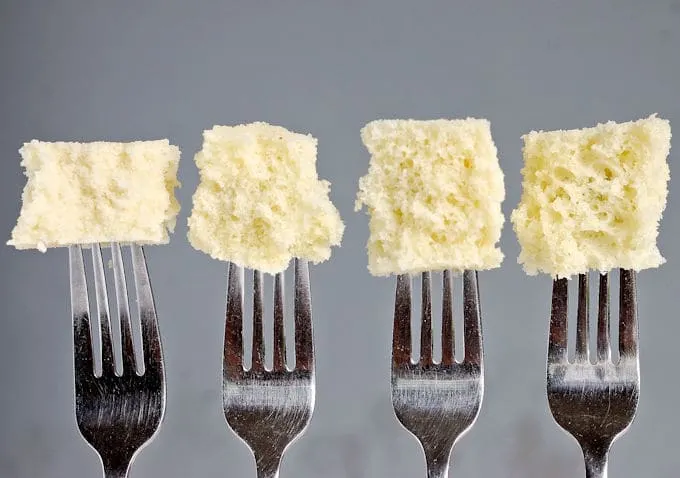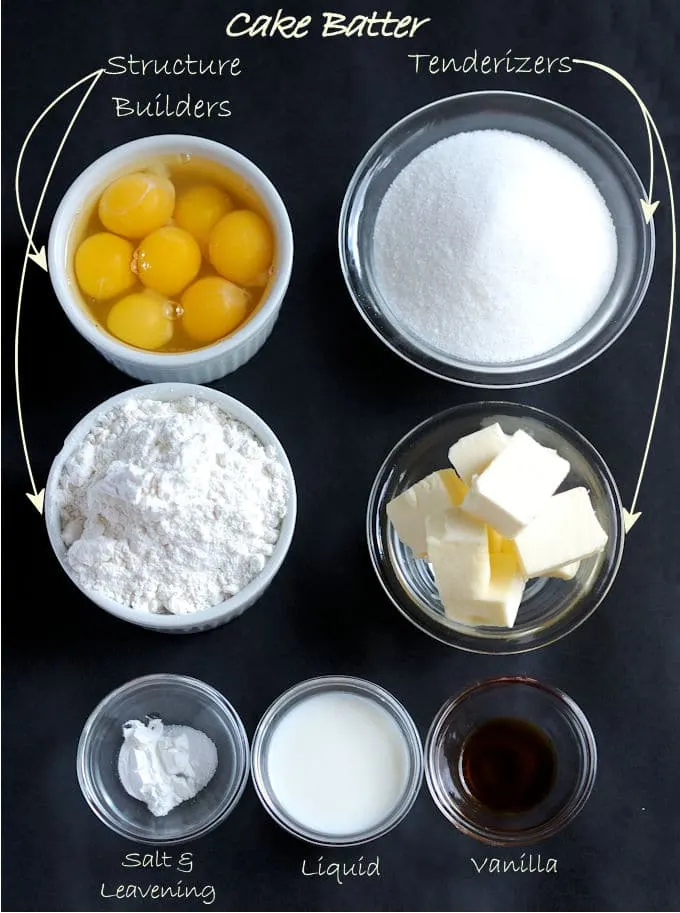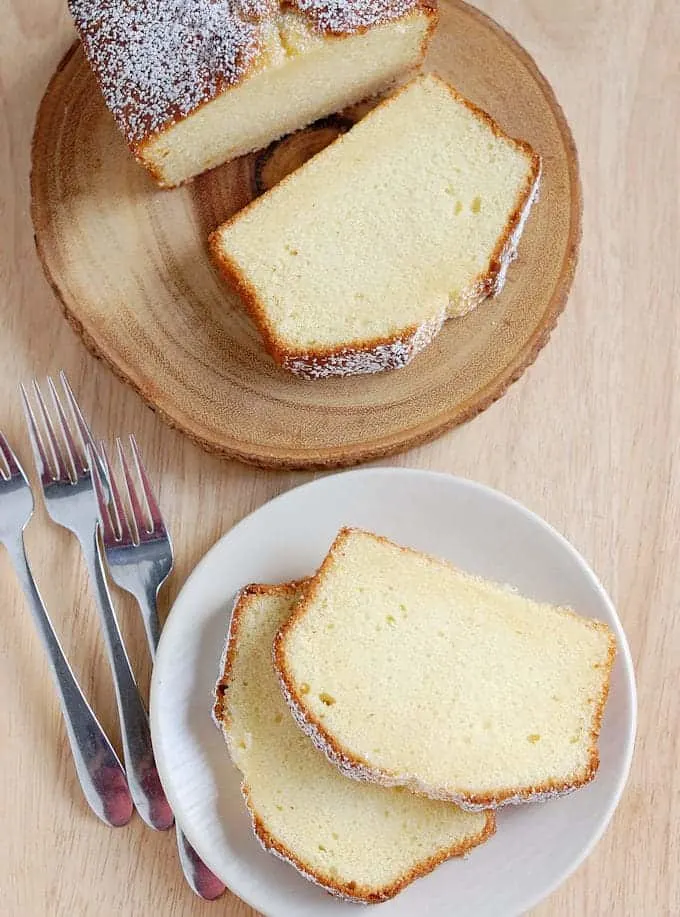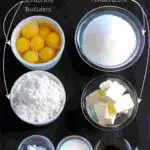How to create the best Cake Recipes
In this article we’ll learn how to create a great cake recipe using the Baker’s Formula.
The information in this article is the culmination of all our Cake Batter classes, but can also stand alone. If you’d like to follow the classes in order visit the Baking School/Science of Cake Batter page.

Use the Baker’s Formula for making the best cakes
To make a perfectly moist and soft cake you’ll first need to understand the concept of the baker’s formula.
A successful cake recipe balances the ingredients that strengthen the cake structure (flour and eggs) with the ingredients that weaken and tenderize the cake structure (sugar and fat).
The Baker’s Formula is used to calculate the proper percentage of each ingredient for a successful recipe. The flour in the recipe is designated at 100% and all the other ingredients are designated relative to the flour. This is a very important point, so keep it in mind as we get deeper into it.

Lean Cakes vs. High Ratio Cakes
About Lean Cakes:
A pound cake recipe made with equal weights of flour, sugar, butter and eggs is a so-called “lean cake”. A “lean cake” has a very simple 1:1 formula balancing the structure-builders with the tenderizers.
The only liquid in the original recipe comes from the eggs (egg whites are 90% water).
About High Ratio Cakes:
While a lean cake is made with equal proportions of flour and sugar, a high ratio cake has a higher proportion of sugar to flour.
In order for a high ratio cake to have good structure we need to adjust some of the other ingredients to keep the cake formula balanced.
Liquid brings together the structure builders and the tenderizers in the batter. The liquid activates the gluten and swells the starch in the flour. The liquid also dissolves the sugar and helps disperse the fat throughout the batter and, of course, provides moisture.
If we use cake flour, with it’s finely ground starch that absorbs extra moisture, we can change the Baker’s Formula to allow for more liquid.
We can also use an emulsifier in the batter to help bind the liquid and fat in the batter. This allows for even more liquid in the recipe, and thus more sugar since you need liquid to dissolve sugar.
A cake made with cake flour and an emulsifying agent can now be higher than 1:1 (sugar:flour) without compromising the structure.

Adjust the Baker’s Percentages for A Better Pound Cake
I used the original quatre quarts pound cake recipe as the basis for all the cake batter classes because the simple 1:1:1:1 ratio makes it very easy to measure changes. So that is the recipe I will use to show you how to use the baker’s formula to improve a cake recipe.
The first step was to lighten the crumb a tiny bit, so I added a little baking powder to the recipe. A pinch of salt and a teaspoon of real vanilla extract were added to enhance the flavor.
Now that the cake was lighter I wanted to sweeten things up a bit. The Baker’s Formula for a high ratio cake allows for up to about 140% of the weight of sugar to flour. I found in my testing that I like pound cake with a ratio of 125% sugar to 100% flour. With this in mind I increased the sugar in the recipe from 8 oz to 10 oz.
I also wanted to add a little extra liquid for moistness, so I needed an emulsifier in the batter. Vegetable shortening will act as an emulsifier, but I prefer an all-butter cake for the unparalleled flavor.
Instead of using shortening in the batter, I used a few extra egg yolks because yolks are great emulsifiers and also add a little extra fat and flavor to the batter. I changed the 8 oz of eggs in the recipe to 3 whole eggs and 4 extra yolks.
Now that we have cake flour and emulsifying eggs yolks in the recipe we can add a little more liquid for additional moisture. I added whole milk as the liquid for a basic pound cake recipe.
The revised recipe makes the perfect melt-in-your-mouth buttery pound cake.
Adjust Baker’s Formula for A Lighter Vanilla Layer Cake
Of course the Baker’s Formula is not only useful for perfecting pound cake recipes. We can continue to test the limits of the structure builders and tenderizers to create a whole world of cake recipes.
I’ll give you another example. As I said, the perfect pound cake should have a dense, buttery texture that doesn’t need any icing at all. But a Vanilla Layer Cake is meant to be filled and iced with frosting. So a great Vanilla Layer Cake should be a little lighter and softer than a pound cake.
As a comparison, let’s look at the Baker’s Percentages for my Pound Cake Recipe vs. my Vanilla Butter Cake Recipe:
| Pound Cake | ||
| Flour | -8 oz | 100% |
| Fat | -9 oz | 112% |
| Sugar | -10 oz | 125% |
| Eggs | -8 oz | 106% |
| Liquid | -7.5 oz (w/eggs) |
| Vanilla Cake | ||
| Flour | -9 oz | 100% |
| Fat | -10.6 oz | 116% |
| Sugar | -12 oz | 133% |
| Eggs | -6.6 oz | 73% |
| Liqui | -12 oz (w/eggs) |
Ok, that’s a lot of information. But lets look at the percentages. (Remember: all percentages are relative to the weight of flour in the recipe.)
By just looking at the percentages you can guess that the vanilla cake will be a little more tender (more sugar and fat), a little sweeter (more sugar) and a little more moist (more liquid) than the pound cake.
The vanilla cake recipe also has more leavening and I whip the whites before adding them to the batter. So the vanilla cake also has a more open and light crumb than the pound cake.
Whew!!! So, all those small changes to the basic formula created a lighter, sweeter and softer cake. That’s just what I want for a cake that will be filled and iced with buttercream.
The takeaway here is that every cake recipe in the universe is some variation on this formula. The type of fat or liquid can change, additional ingredients can be added, but it’s always about the balance between structure and softness.
It’s the variations that create the myriad of cake recipes that we can invent and perfect.


Hello Eileen,
I have read through your way of perfecting a cake and it was soooo helpful!! Me and my cousin are looking into starting a home bakery delivery service kind of thing (somewhere in the future that is since we’re only 15 at the moment) and this website has great input for cake recipes we will use this recipe as our base for selling cakes in the future (with your permission for us to steel and adapt it)! Thanks soooo much again!!
Sure, go ahead and use my recipe as a starting point. Every recipe is the world is a variation or adaptation of another recipe. Good luck with your business.
Please update details about eggless variants. Thank you
That would take an enormous amount of research and testing to do.
Hi I tried the vanilla butter cake, followed the instructions to the letter but after taking the cake out of the oven it collapsed. Have tried again in another oven and put an extra oven thermometer in to check temp, this time it collapsed in the oven!. I bake cakes all the time and never have this problem. I was really looking forward to trying some of your recipes but have rather been put off now. Any ideas about what could be going wrong.
What do you mean my “collapsed”. Did the cake pull back a bit from the sides but if you cut it open the crumb seems fine? That can happen, especially if the cake is over-baked a bit. The vanilla butter cake recipe is the one I used in my wedding cake business for 10 years. So I’ve baked that cake, literally, thousands of times in every size from cupcakes to 14″ rounds. So I know it’s a good recipe. I can’t say for sure what happened from your description. Generally, if a cake over-rises and then falls it’s a problem with the leavening. Do you use self-rising flour by any chance?
No I didn’t use SF flour I contacted you about the flour and used plain with corn starch. It didn’t just pull away from the sides it sunk completely and had a sad layer. This also happened to the one which collapsed in the oven. I took a picture of it if it’s possible to send?
Hi !
Wow this post is so amazing ! Well the whole website is amazing !!
I have several tricky question, I don’t know if you can help me
1. what should be the liquid proportion to flour ? should it be 1 part liquid (excluding egg) for 1 part flour ?
2. How to calculate “double purpose ingrédient”. Example , if I use oil as fat, should I calculate in the liquid too or I calculate just as a fat ? Example if I use cream as a liquide, should I calculate in the fat too or I calculate just as a liquid ?
3. In the table comparing the percentage I don’t uderstand how the liquid is calculated. So first table it said 7,5 oz liquide with eggs. But eggs its said 8 oz and the only other liquid I see its milk 2 oz. So I don’t uderstand the 7,5 oz ? In the second table is 12 oz liquid with eggs. But for the eggs it say 6,6 oz and sour cream 8 oz. So I don’t understand the 12 oz ?
Thank you 🙂
1. The liquid should be measured in proportion to the sugar. For a high ratio cake the liquid can equal or exceed the weight of the sugar. That means there is enough liquid to dissolve the sugar in the batter and to react with the starch in the flour. There is not a set amount of liquid that you need to have in the cake. Using an emulsifier (yolks) and cake flour allows more moisture in the batter which allows for more sugar in the batter. That’s why modern high ratio cakes are sweeter and moister than the traditional cakes made with equal weights of flour-sugar-butter-eggs.
2. Double purpose ingredients should count both. For example, eggs add fat, protein and moisture. All three should be considered in formula.
3. The 7.5 oz of liquid includes the amount of water in the milk (milk also has fat, protein, etc) and the amount of water in the eggs. The 12 oz of liquid in the vanilla cake is made up of the liquid in the eggs and the sour cream (again sour cream is made up of fat, protein and liquid).
I hope this answers your questions. Again, the formula is a guide and there isn’t one “perfect” cake formula. The cake formula is not a set of “rules” really so much as a way of explaining how a cakes texture is affected by the variation of ingredients. You can push the limits with any of the ingredients to get the texture you’re after. In fact, in my white cake post I acknowledge that the cake will “settle” as it comes out of the oven because it is a very tender cake. I’m fine with that because I like the final texture of the cake. There is no such thing as “correct” or “perfect” cake recipe. That’s where the “art” (and fun!) of baking comes in.
Thank you for the info 🙂
Hello Eileen,
These lessons are exactly what I was looking for, thank you so much for sharing your knowledge! I am curious, how do you decide how many egg yolks to add as emulsifiers? Is there some kind of formula for that?
Hi Rasa, I don’t have a formula, I tend to test and tweak until I get a result that I’m happy with.
I absolutely felt in love with your blog!!! Congrats on your great passion for baking! It is a little hard to find such a science lover who puts a lot of effort on explaining things like you post!!
Talking about % in these recipes, did you analize the amount of water in fat (butter in this case)? If the answer is no, why not ? Wouldn’t consistency change if you change the source of fat? (For example: oil instead of butter)
Thank you!
No I didn’t include the water from the butter, which would be a little more than an ounce. The most important point about the liquid is that using emulsifiers allows more liquid in the batter. Using oil instead of butter will change the flavor and texture of the cake batter. You can see some tests of different fats in cake batter in this post. I believe that difference is mostly due to the fact that oil is liquid at room temp and butter is solid. Also, the flavor and mouth feel is different.